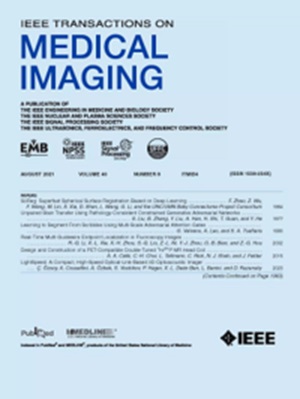Bidirectional Semi-supervised Dual-branch CNN for Robust 3D Reconstruction of Stereo Endoscopic Images via Adaptive Cross and Parallel Supervisions
IF 8.9
1区 医学
Q1 COMPUTER SCIENCE, INTERDISCIPLINARY APPLICATIONS
引用次数: 0
Abstract
Semi-supervised learning via teacher-student network can train a model effectively on a few labeled samples. It enables a student model to distill knowledge from the teacher's predictions of extra unlabeled data. However, such knowledge flow is typically unidirectional, having the accuracy vulnerable to the quality of teacher model. In this paper, we seek to robust 3D reconstruction of stereo endoscopic images by proposing a novel fashion of bidirectional learning between two learners, each of which can play both roles of teacher and student concurrently. Specifically, we introduce two self-supervisions, i.e., Adaptive Cross Supervision (ACS) and Adaptive Parallel Supervision (APS), to learn a dual-branch convolutional neural network. The two branches predict two different disparity probability distributions for the same position, and output their expectations as disparity values. The learned knowledge flows across branches along two directions: a cross direction (disparity guides distribution in ACS) and a parallel direction (disparity guides disparity in APS). Moreover, each branch also learns confidences to dynamically refine its provided supervisions. In ACS, the predicted disparity is softened into a unimodal distribution, and the lower the confidence, the smoother the distribution. In APS, the incorrect predictions are suppressed by lowering the weights of those with low confidence. With the adaptive bidirectional learning, the two branches enjoy well-tuned mutual supervisions, and eventually converge on a consistent and more accurate disparity estimation. The experimental results on four public datasets demonstrate our superior accuracy over other state-of-the-arts with a relative decrease of averaged disparity error by at least 9.76%.双向半监督双分支CNN通过自适应交叉和并行监督实现立体内窥镜图像的鲁棒三维重建
通过师生网络进行半监督学习可以在少数标记样本上有效地训练模型。它使学生模型能够从教师对额外未标记数据的预测中提取知识。然而,这种知识流通常是单向的,其准确性容易受到教师模型质量的影响。在本文中,我们通过在两个学习者之间提出一种新的双向学习方式来寻求立体内窥镜图像的鲁棒3D重建,每个学习者都可以同时扮演教师和学生的角色。具体来说,我们引入了两种自监督,即自适应交叉监督(ACS)和自适应并行监督(APS),以学习双分支卷积神经网络。两个分支预测相同位置的两个不同视差概率分布,并将它们的期望值输出为视差值。学习的知识沿着两个方向在分支之间流动:交叉方向(ACS中的视差引导分布)和平行方向(APS中的视差指导视差)。此外,每个分支还学习置信度,以动态地完善其提供的监督。在ACS中,预测的视差被软化为单峰分布,置信度越低,分布越平滑。在APS中,通过降低置信度低的预测的权重来抑制不正确的预测。通过自适应双向学习,这两个分支可以享受良好的相互监督,并最终收敛于一致且更准确的视差估计。在四个公共数据集上的实验结果表明,与其他现有技术相比,我们的精度更高,平均视差误差相对降低了至少9.76%。
本文章由计算机程序翻译,如有差异,请以英文原文为准。
求助全文
约1分钟内获得全文
求助全文
来源期刊

IEEE Transactions on Medical Imaging
医学-成像科学与照相技术
CiteScore
21.80
自引率
5.70%
发文量
637
审稿时长
5.6 months
期刊介绍:
The IEEE Transactions on Medical Imaging (T-MI) is a journal that welcomes the submission of manuscripts focusing on various aspects of medical imaging. The journal encourages the exploration of body structure, morphology, and function through different imaging techniques, including ultrasound, X-rays, magnetic resonance, radionuclides, microwaves, and optical methods. It also promotes contributions related to cell and molecular imaging, as well as all forms of microscopy.
T-MI publishes original research papers that cover a wide range of topics, including but not limited to novel acquisition techniques, medical image processing and analysis, visualization and performance, pattern recognition, machine learning, and other related methods. The journal particularly encourages highly technical studies that offer new perspectives. By emphasizing the unification of medicine, biology, and imaging, T-MI seeks to bridge the gap between instrumentation, hardware, software, mathematics, physics, biology, and medicine by introducing new analysis methods.
While the journal welcomes strong application papers that describe novel methods, it directs papers that focus solely on important applications using medically adopted or well-established methods without significant innovation in methodology to other journals. T-MI is indexed in Pubmed® and Medline®, which are products of the United States National Library of Medicine.
 求助内容:
求助内容: 应助结果提醒方式:
应助结果提醒方式:


